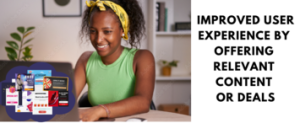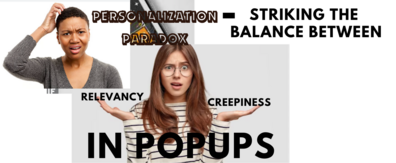It’s winter; and Maryjane wants to order some cozy blankets online. As she browses online checking for the best blankets to buy, a popup appears, addressing her by her name and recommending a perfect match.
Intrigued, she clicks on it, only to find that the website knew her recent search history and even her location. Unease settles immediately as the site makes a suggestion that highlights her daily routine and preferences.
‘Imagine wrapping up in this blanket while watching your favorite show at 8pm.’
READ ALSO
- The Secret Tool to Sell More Custom T-shirts on Your Ecommerce Websites
- Gamification Power: How Interactive Popups Can Boost Engagement and Sales
- Pop-Up Psychology: 7 Underrated Strategies to Skyrocket Conversions in 2024
- Beyond Exit Intent: 5 Advanced Popup Triggers Ecommerce Stores are Missing out on
- Popups for Customer Education and Support: Providing Valuable Resources
This intrusive familiarity makes her feel like someone is spying on her. Could it be a hacker watching her movements? As far as she is concerned, her privacy has been violated.
Of course she will immediately close the browser due to fear of being watched.
What then is Personalization in popups?

Personalization in popups analyzes preferences, browsing history, and demographics, and then crafts customized popups, addressing users by name and suggesting relevant products or contents.
Personalization can then be compared to a store assistant whispering deals based on what you’re interested in. It’s like the web knows you, making shopping smoother and maybe even a little exciting.
The benefits of personalization are that it increases the likelihood of conversions and boosts efficiency. It also improves customer satisfaction, as users feel understood and valued.
There’s then a thin line between relevance and creepiness while personalizing popups. It is called the personalization paradox.
Personalization paradox arises when tailored content, aimed at enhancing user experience, becomes too intrusive.
This means that when personalization becomes excessive, it can trigger privacy concerns as the users feel invaded.
Striking the balance is then crucial in optimizing popup usage. E-commerce owners should create personalized experiences that respect user boundaries.
This article is here to guide ecommerce owners on personalizing popups without compromising user privacy.
The Benefits of Personalized Popups
To know how to build an effective personalized popup, e-commerce owners must first know and understand the benefits of personalized popups. Some benefits of personalized popups are listed below:
- Increased engagement and conversion rates
- Improved user experience by offering relevant content or deals
- Building brand loyalty through targeted interaction
YOU MAY WANT TO KNOW! – How Interactive Popups Can Boost Engagement and Sales
Increased engagement and conversion rates
The strategic use of personalized popups enhances the overall user experience, increasing engagement and conversion rates.
Personalized popups are like moths to the user’s online flame, showing them stuff that they’re already into. It’s like a little nudge that turns window shopping into buying sprees.
Improved user experience by offering relevant content or deals

Personalized popups ensure that users are presented with information or promotions that align with their needs.
By recognizing and addressing user-specific preferences, personalized popups then enhance user experience.
This then saves the user’s time and frustration, skipping past the junk to show them exactly what they want.
Building brand loyalty through targeted interaction
Addressing individuals by name, understanding their preferences, and offering tailored promotions create a sense of exclusivity and personal connection.
Personalized popups then show each customer that they are valued, which in turn enhances the overall relationship. It’s a subtle form of flattery that makes the customer feel special thereby building trust and a sense of personal connection.
Users are more likely to engage with and remember this brand because of the customized experience that they provide. This leads to repeat visits and increased loyalty.
Examples of effective personalized popups
To help our readers, we will now explore some examples of effective personalized popups:
- Exit-Intent Popups with Personalized Offers
- Birthday or Anniversary Reminders with Exclusive Deals
- Geo-Targeted Popups with Local Relevance
- Product Recommendation Popups Based on Browsing History.
READ NOW! – 10 Exceptional Strategies to Boost Customer Engagement with Popups Optimization
The Creeping Factor
Where then does the creeping factor come in, in personalization popups? That is, when do users stop feeling special and start feeling like their privacy is being invaded?
While users want to feel special, they also want to maintain a certain level of control in their lives. They want their privacy to be respected.
When popups display an extensive knowledge of an individual’s personal details, such as browsing history, location, or preferences, users may perceive it as a breach of their privacy.
It can then be said that personalization has crossed the line.
Finding the Balance
How then can an e-commerce owner find the balance between relevancy and creepiness in personalized popups
Data collection and usage
The first step is to be transparent about what data is collected and how it’s used.
To maintain user trust, websites should clearly communicate what data is collected, why, and how it will be utilized – this highlights the importance of transparency.
Transparency promotes understanding and allows users to make informed decisions about sharing information.
Privacy policies and consent mechanisms ensure users feel in control, mitigating concerns about invasive practices.
When e-commerce owners respect user’s privacy, personalization then feels like a helpful friend instead of a creepy stalker.
Targeting techniques
Instead of only relying on extensive personal data, employ anonymized and aggregated data to ensure user privacy. Utilize behavioral targeting, focusing on user actions without delving into sensitive details.
Implement frequency capping to prevent a sense of intrusion.
Focus on relevant offers and avoid overly specific targeting. For instance, e-commerce owners can use broad categories like browsing history or recent purchases, instead of personal details like medical info or past relationships.
Timing and frequency
Show popups at the right time and avoid bombarding users!
E-commerce owners should program popups to appear when users are likely to be receptive and avoid bombarding them with excessive popups.
Those timely popups can be controlled by setting frequency limits, opting for non-intrusive moments – such as when a user pauses or completes an action – and using cookies to remember when popups have been shown, preventing repetition.
Design and messaging
Use clear, concise language and avoid manipulative tactics.
E-commerce owners should craft visually appealing popups that seamlessly integrate with the website’s aesthetics, preventing an abrupt or invasive feel.
They should also use clear and concise messaging that communicates the value of the personalized content and respects user privacy.
They should be senstive to use languages that are not too familiar or intrusive.
E-commerce owners should stick to being approachable and informative, nothing more.
User control
Allow users to easily opt out of receiving personalized popups.
Empowering users to manage their preferences, control the frequency of popups, and easily opt-out instills a sense of autonomy.
E-commerce owners should provide clear and accessible privacy settings that allow users to customize the level of personalization that they are comfortable with.
They should also show users that they respect their boundaries and preferences by putting them in charge of their own experience.
Examples of Well-Balanced Popups
Below are real-world examples of popups that achieve personalization without creepiness.
- The first scenario would be a travel website that uses non-intrusive banners acknowledging the user’s name and suggesting products related to their previous purchases without seeming too familiar.
- Another great example is when a user is browsing a furniture store, eyeing a sleek armchair. As the user is about to exit, a popup appears, showcasing a matching ottoman at a discounted price.
- A baker has been searching for baking recipes for weeks. Just at the right time, a popup from his/her favorite grocery store appears and offers a discount on the exact ingredients the baker needs for that decadent chocolate cake.
- Imagine you are a student and you are stuck on a DIY project. Just then, a popup with a short, interactive video tutorial for the exact step you’re stuck on appears.
Note that the above examples show popups that are relevant and helpful but not pushy.
What then makes these popups successful and how do they apply the outlined principles?

You may be asking what makes these popups different and more effective than the ones you’ve been using. Consider the points listed below to see what makes popups successful.
Firstly, a successful popup leverages relevant data without crossing into sensitive territories, ensuring that personalization is based on user actions and preferences rather than intrusive details.
Secondly, successful popups take into importance timely and context-aware deployment, avoiding interruptive appearances and respecting user engagement patterns.
Thirdly is the optimal frequency control. This prevents annoyance, as successful popups strategically appear at non-intrusive moments.
Fourthly, is transparency about data usage and giving users control over their experience.
Wrapping Up,
Now, e-commerce owners must never forget the importance of striking a balance between relevancy and creepiness in popups.
Ability to achieve that will increase engagement and conversion rates, improve user experience by offering relevant content or deals, and build brand loyalty through targeted interaction.
Feel free to share your own experiences with personalized popups and discuss the future of this marketing tool in the comment section below.
CHECK OUT ALSO!
- The Secret Tool to Sell More Custom T-shirts on Your Ecommerce Websites
- Popups for Upselling and Cross-selling: Boosting Average Order Value
- Gamification Power: How Interactive Popups Can Boost Engagement and Sales
- 10 Exceptional Strategies to Boost Customer Engagement with Popups Optimization
- Pop-Up Psychology: 7 Underrated Strategies to Skyrocket Conversions in 2024
- Beyond Exit Intent: 5 Advanced Popup Triggers Ecommerce Stores are Missing out on
- Popups for Customer Education and Support: Providing Valuable Resources

